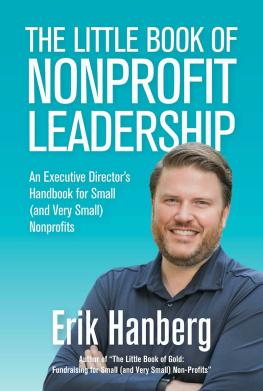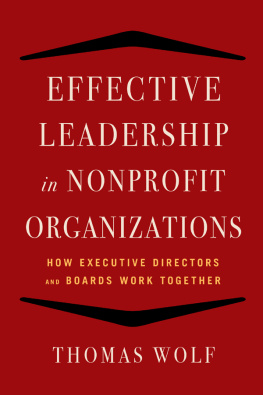Copyright2012 by Peter C. Brinckerhoff. All rights reserved.
Published by John Wiley & Sons, Inc., Hoboken, New Jersey.
Published simultaneously in Canada.
No part of this publication may be reproduced, stored in a retrieval system, or transmitted in any form or by any means, electronic, mechanical, photocopying, recording, scanning, or otherwise, except as permitted under Section 107 or 108 of the 1976 United States Copyright Act, without either the prior written permission of the Publisher, or authorization through payment of the appropriate per-copy fee to the Copyright Clearance Center, Inc., 222 Rosewood Drive, Danvers, MA 01923, (978) 750-8400, fax (978) 646-8600, or on the Web at www.copyright.com . Requests to the Publisher for permission should be addressed to the Permissions Department, John Wiley & Sons, Inc., 111 River Street, Hoboken, NJ 07030, (201) 748-6011, fax (201) 748-6008, or online at www.wiley.com/go/permissions .
Limit of Liability/Disclaimer of Warranty: While the publisher and author have used their best efforts in preparing this book, they make no representations or warranties with respect to the accuracy or completeness of the contents of this book and specifically disclaim any implied warranties of merchantability or fitness for a particular purpose. No warranty may be created or extended by sales representatives or written sales materials. The advice and strategies contained herein may not be suitable for your situation. You should consult with a professional where appropriate. Neither the publisher nor author shall be liable for any loss of profit or any other commercial damages, including but not limited to special, incidental, consequential, or other damages.
For general information on our other products and services or for technical support, please contact our Customer Care Department within the United States at (800) 762-2974, outside the United States at (317) 572-3993, or fax (317) 572-4002.
Wiley also publishes its books in a variety of electronic formats. Some content that appears in print may not be available in electronic books. For more information about Wiley products, visit our web site at www.wiley.com .
Library of Congress Cataloging-in-Publication Data:
Brinckerhoff, Peter C., 1952
Smart stewardship for nonprofits: making the right decision in good times and bad/
Peter C. Brinckerhoff.
p. cm. (Wiley nonprofit authority; 7)
Includes bibliographical references and index.
ISBN 978-1-118-08367-3 (cloth); ISBN 978-1-118-22277-5 (ebk);
ISBN 978-1-118-23664-2 (ebk); ISBN 978-1-118-26161-3 (ebk)
1. Nonprofit organizations. 2. Decision making. 3. Problem solving. I. Title.
HD62.6.B75 2012
658.15'9dc23
2011043313
For my amazing wife Chris: Marrying you
in 1978 was the best decision of my life.
Acknowledgments
Any book starts with one or more ideas that tend to roll around in your head for a while, percolate and then, one day, you realize that you may have the material for a book. For this book, the initial work that wound up in these pages was all done around collaborative innovation with three amazing people, Tim Brostrum from the Fieldstone Alliance, Fran Loosen, now with the Kellogg Foundation, and Jeff Nugent, from The Center for Leadership Innovation. Tim, Fran, Jeff, and I worked together for just more than 18 months, and our conversations and collaboration were one of the personal highlights of my career in nonprofits. You see the results of their inspiration throughout the book.
The next person I have to thank is Deborah Atkinson, Executive Director of Learning and Performance Excellence at NISH, a national nonprofit headquartered in Vienna, Virginia. Deborah runs the best national training program for nonprofits anywhere, and I've had the privilege of working with, and learning from, her for nearly 20 years. Deborah saw a presentation I did on collaborative innovation in Port of Spain, Trinidad, and asked me to flesh out a two-day training course that was about innovation in a rapid growth environment. As I thought through the pieces of that course one afternoon, I had my Aha! There's a book in this material! moment, and Deborah gets much of the credit for improving the material contained here.
I spent considerable time working with the three case organizations, whose chief executive officers (CEOs) and staff gave me great feedback and anecdotes about their experiences with decision making and organizational growth. All three are exemplary nonprofits, among the best the United States has, and I greatly appreciate all the time and energy they devoted to helping me. Particular thanks go to Mitch Tomlinson and the staff at Peckham Industries in Lansing, Michigan, Mark and staff at Lakeview Christian Church, and Ray Bishop and his staff at Goodwill Industries of North Georgia. You all are an inspiration, both to me and to your communities.
Chapter 1
Introduction
Overview
Welcome.
I hope this finds your nonprofit stable, growing at a healthy pace, providing high-quality mission, and using best practices in management, human resources, technology, and finance. I also hope your board fully understands the mission and the staff, and that all of your organization's key stakeholders are in lockstep as to your mission priorities, values, and the best way forward.
I hope.
Unfortunately, if you are like most nonprofit staff or volunteers, when you read the paragraph above you thought, for all or part of it, I wish.
So do I.
This book is designed to be a tool to get your organization closer to the nonprofit nirvana described above. In my 30 years staffing, leading, volunteering, consulting, and training nonprofits, I have seen many nonprofits that are in the place described above. It's hard to get there and harder to stay there. It requires constant management and board attention to mission, values, culture, communications, and the entire community of stakeholders. Even when you are doing everything on that list, it's easy to go off course.
I hold a private pilot's license and flew regularly for 25 years. I've also sailed all my life. It always intrigued me that the rule in both disciplines is the same: Look away for three seconds and you're off course. Three seconds. Thus, constant attention to your desired direction is crucial. First, though, you've got to get yourself and your nonprofit on the best mission course to start with.
And that's really what this book is about. Helping you get the mission, values, culture, tools, and skills to get your nonprofit on the right path and keep it there. For some organizations this will require big decisions and major course corrections. For others, a tweak here and an improvement there and you'll nearly be on autopilot.
In the pages that follow, I'll show you how to become a Smart Steward of your nonprofit's resources, and how to develop and use a decision making framework that your board and staff can use to move your mission forward, as well as the work that needs to be in place before you build that framework. A common decision process that is fully understood by staff and board is a huge advantage to your mission maximization efforts.
We'll also discuss developing a culture of constant innovation, both in the why and the how, and I'll provide you with tools to solve the knottiest problems out there. We'll investigate ways to incorporate your mission and values in everything everyone does in your nonprofit every day.
The ultimate goal, of course, is better mission for the people you serve. Sometimes better mission comes from a small, tactical decision made right at the line of service. Sometimes it's a huge strategic policy choice made by the board of directors. But whether big or small, all your decisions should make your organization more mission capable in very specific ways we'll examine in the coming pages.









